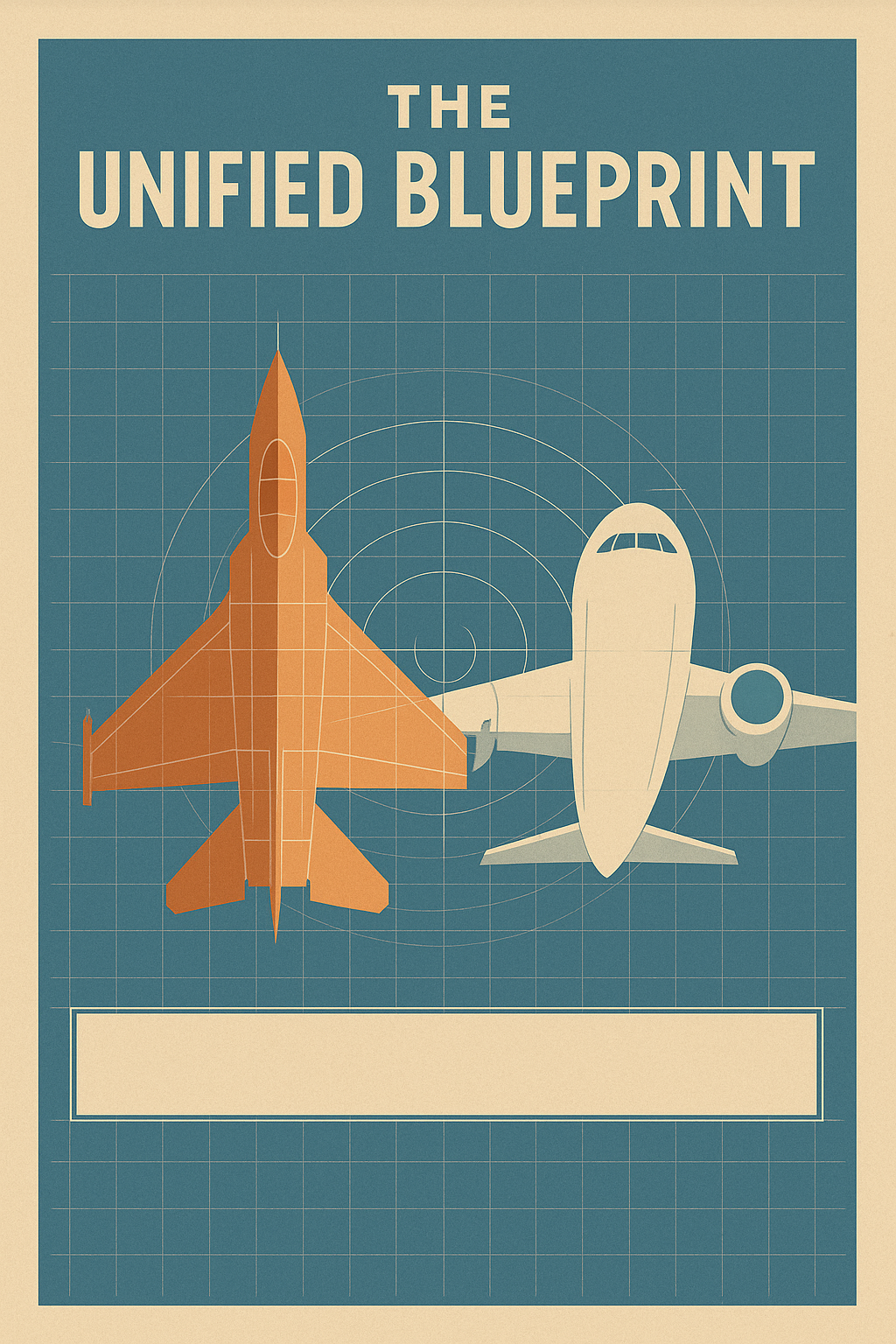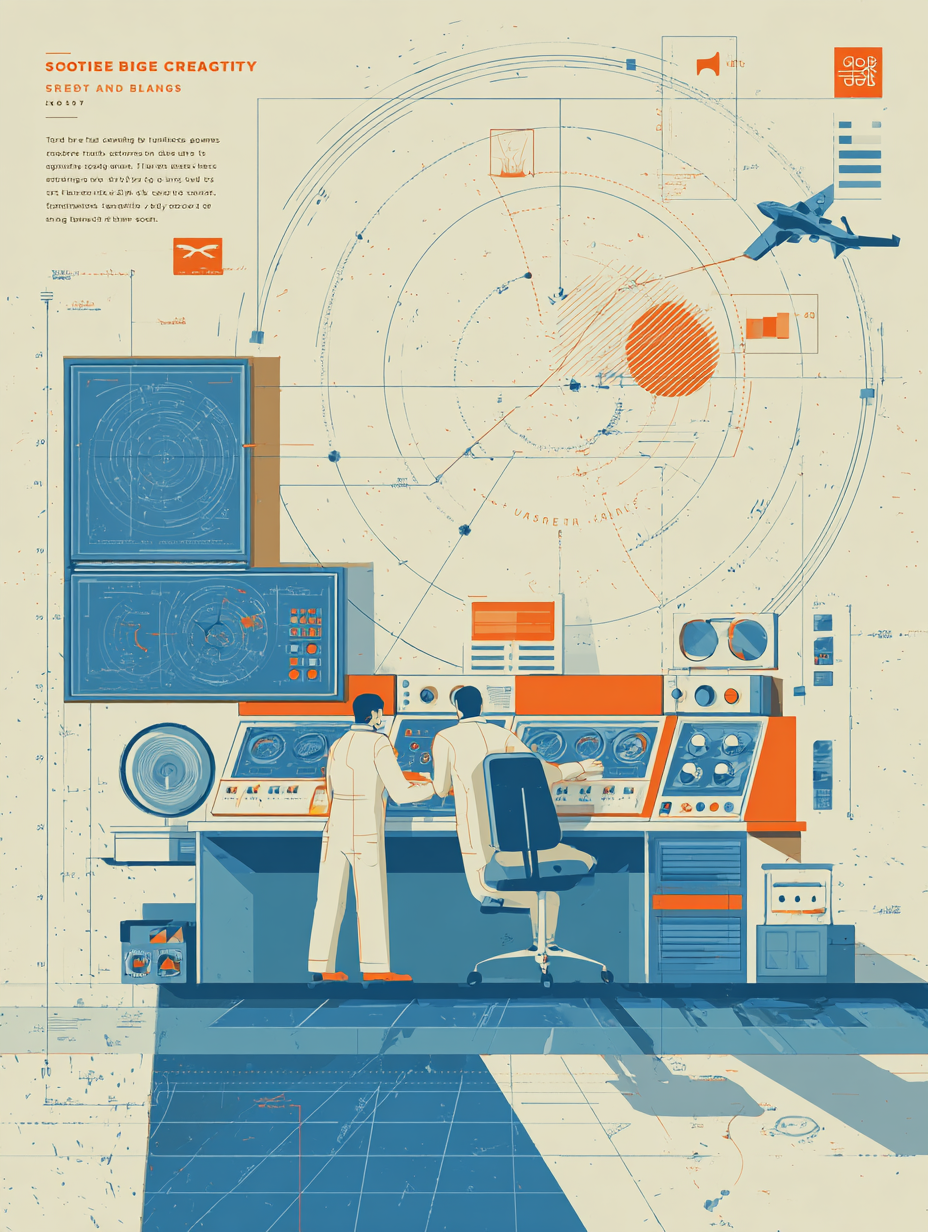You’ve just overseen a high-stakes merger in the defense or aerospace space.
You’ve got millions in contracts, cutting-edge tech integrations on the horizon, and a powerhouse of combined talent.
But here’s the catch: no one knows who you are anymore.
Your brand—the one that got you into rooms with the DoD, top-tier OEMs, and MRO giants—just dissolved into a post-merger identity crisis.
And it’s not because your new company lacks capability; it’s because the rebrand hasn’t landed.
Truth is, even if you’re sitting on one of the largest inventories of factory new and used serviceable material, if the market can’t recognize or rally behind your new name, you’ve lost your edge before takeoff.
Rebranding isn’t just a logo swap—it’s a strategic mission, especially in defense and aerospace, where brand equity drives contracts, investor confidence, and trust at trade shows and beyond.
I’m Viktor. I’ve spent over a decade helping companies craft narratives and strategies that close million-dollar deals. In this playbook, I’ll walk you through a rebranding strategy that isn’t just compliant or creative—it’s conversion-driven, culturally aligned, semantically structured, and built to dominate the aerospace and defense market.
Let’s get to work.
The Strategic Imperative of Rebranding Post-Merger
In the defense and aerospace industry, your brand is a signal of competence, credibility, and compliance.
When a merger or acquisition occurs, especially in high-stakes sectors like aerospace, aviation maintenance, or defense systems, brand identity becomes a strategic asset, not a secondary concern.
For companies supplying commercial aircraft components, managing AOG (Aircraft on Ground) responses, or holding contracts with defense agencies, brand recognition directly influences trust.
It determines whether a procurement officer in the U.S. Department of Defense sees your new entity as a reliable supplier—or a risky unknown.
Consider the Raytheon and United Technologies merger.
When these two aerospace giants combined, it wasn’t just a structural merger; it was a calculated rebrand.
The resulting entity, Raytheon Technologies, adopted a new brand name that preserved legacy equity while signaling innovation, scale, and leadership in the future of aerospace.
This wasn’t about aesthetics—it was about instilling confidence in investors, governments, and global aviation partners.
Investor confidence also hinges on how clearly a post-merger rebrand communicates stability and growth drivers.
When private equity firms like Acorn Growth invest in aerospace suppliers, one of the first mandates is often brand unification—ensuring consistent messaging across all touchpoints, from trade shows to avionics part catalogs.
And let’s not forget operational visibility.
In a landscape where defense contracts are influenced by perception, clarity in branding—especially when you’re officially rebranded—can spell the difference between being seen as a global aviation leader or getting buried in an OEM’s supplier list.
Tactical vs. Strategic Rebrands
Not all rebrands are created equal—especially in aerospace and defense, where margins for error are razor-thin.
A tactical rebrand involves surface-level changes like a new logo, updated color palette, or name change.
It may reflect a shift in ownership or simply modernize a legacy aesthetic. This works when brand equity remains strong and the core business model is untouched—common in vertical acquisitions where the product offering remains consistent.
A strategic rebrand, however, signals a full-scale repositioning.
This occurs when an acquisition or merger reshapes the value proposition, organizational structure, or geographic focus of the company.
In such cases, a new brand identity isn’t just cosmetic—it’s foundational.
It’s the difference between painting over cracks and rebuilding with reinforced steel.
Take the recent integration of Aerospares 2000 and Sentry Aerospace. Under Acorn Growth’s ownership, these two aviation suppliers merged, forming a combined company with one of the largest inventories of factory new and used serviceable material.
But the rebrand went beyond logos. The decision to align the new brand with global aviation trends, unify messaging across cargo operators and MROs, and address cultural gaps between teams reflects a strategic shift built for the future of aerospace.
So, how do you decide?
Go tactical if your acquisition retains operational autonomy and brand equity is an asset you want to preserve.
Go strategic if your merger creates a new entity with expanded capabilities, markets, or messaging needs—and you need brand consistency across divisions, regions, and trade shows.
In the post-merger environment, clarity beats cleverness. Whether you’re entering new business areas or competing on the global stage, your rebrand must cut through the noise and say exactly who you are—and why you matter.

Assessing Brand Equity and Risk Before the Rebrand
Before launching a rebranding campaign post-merger, it’s critical to assess the brand equity of both legacy entities. Why?
Because in the high-stakes world of aerospace and defense, perception drives procurement. The strength—or weakness—of your existing brand determines how your new identity will be received by defense agencies, OEMs, commercial aviation clients, and MRO networks across global markets.
Entity Mapping and Semantic Associations
Your first move? Map your brand entities using natural language processing (NLP) to uncover how your company is recognized and associated in digital ecosystems.
Entity mapping involves identifying and evaluating how your brand appears in media, reports, search engines, and AI-driven tools.
By leveraging platforms like Google’s NLP API, IBM Watson Discovery, and OpenCalais, you can extract key associations (e.g., “aviation maintenance,” “factory new,” “aircraft MRO”) and understand what topics your brand is topically linked to.
For instance, does your current identity surface as a leader in the aerospace industry, or is it buried in vague mentions across fragmented supplier listings?
Is your brand semantically aligned with critical defense systems, aviation parts distribution, or aircraft MRO solutions?
These associations help you determine whether your brand is known for precision, reliability, scale—or just commoditized parts.
The goal is to identify gaps. A brand audit might reveal that although your company holds a significant inventory of factory new components, digital mentions fail to convey that authority—especially in the context of M&A activity or trade shows and industry events.
During a post-merger rebrand, these insights guide decisions about whether to keep certain legacy identifiers or retire them entirely as part of a strategic shift.
Stakeholder Sentiment Analysis
Once entity mapping is complete, the next step is stakeholder sentiment analysis—understanding how your brand is perceived both internally and externally.
Internally, assess sentiment across employees, senior leadership, and key partners. In a merger, cultural integration is often where rebrands fail.
If top talent from both legacy organizations doesn’t feel represented by the new logo, name change, or brand messaging, retention and morale can suffer.
Conduct anonymous surveys, leadership interviews, and town halls to map alignment or resistance.
Externally, map brand perception across your highest-stakes audiences:
OEM partners who need consistency in quality and delivery.
Defense agencies (like the DoD) who rely on long-term performance signals.
Airline customers, cargo operators, and MROs that prioritize reliability, lead times, and compliance.
Sentiment monitoring tools like Brandwatch, Talkwalker, or Sprinklr can give real-time insights into how the market views your merger and rebranding plans.
Are stakeholders excited about the combined capabilities of your new entity—or confused about your role in the future of aerospace?
Regional differentiation is also critical. In the Asia-Pacific region, for example, brand trust can be influenced by localization, certifications, and trade alignment.
If your rebrand doesn’t consider linguistic and cultural nuances, especially in fast-growing aviation markets, you’ll lose traction in the very markets driving global expansion.
A well-designed rebrand, backed by semantic analysis and sentiment data, ensures your officially rebranded identity hits the mark—not just aesthetically, but strategically.
Building the Rebrand Strategy for Aerospace & Defense
Crafting a post-merger rebrand in the aerospace sector is about building a brand architecture that reflects your combined capabilities, future vision, and credibility in the global aviation and defense markets.
This section breaks down the essential strategic moves to define, structure, and express a brand identity that stands firm in the face of compliance scrutiny, global expansion, and cultural integration.
1. Define the New Brand Purpose
A successful rebrand begins with why.
Drawing from Simon Sinek’s “Start with Why,” your brand purpose must go beyond features and functions—it should articulate the strategic ‘why’ behind your merger or acquisition, and how the new entity is uniquely positioned to lead in defense innovation, autonomous systems, and sustainable aviation.
Ask: What are we solving in the aerospace industry that no one else is? The answer becomes your strategic north star.
For example, if your post-merger business combines OEM-certified parts supply with AOG responsiveness and avionics capabilities, your purpose could be to “ensure operational readiness for every aircraft in the sky and on the ground.”
That statement not only resonates with military and commercial clients—it clarifies your value in the future of aerospace.
Purpose-led positioning sets the foundation for everything else—from culture integration to trade show messaging to investor presentations.
2. Structure the Brand Architecture
With purpose in place, it’s time to structure how your new brand presents itself across business lines, regional offices, and partner networks.
This decision impacts clarity, scalability, and cost.
There are three core options:
Branded House: A unified brand where all services operate under one name. Ideal for MROs and defense suppliers offering tightly integrated solutions.
House of Brands: Multiple brands operate independently under one parent company. Useful when legacy names have strong recognition in niche aviation segments (e.g., avionics vs. propulsion systems).
Hybrid Model: Combines both—a master brand supported by endorsed sub-brands. Strategic for businesses undergoing phased integration or targeting distinct audiences (e.g., commercial aviation vs. military contracts).
A powerful real-world example is the integration of Sentry Aerospares and Aerospares 2000 Limited, brought together through a merger backed by private equity.
The two aviation suppliers had distinct reputations in the air transport and aircraft MRO space.
The brand architecture needed to preserve operational credibility while presenting a unified global vision.
The solution: a hybrid structure that allowed each name to transition under a cohesive new identity, supported by one strategic mission and visual identity.
The right architecture reduces brand confusion in global aviation directories, regulatory filings, and supplier databases.
It also empowers consistency across cultures, digital channels, and sales operations.
3. Design the New Name and Logo
A new name and logo are the most visible signals of transformation—but also the most sensitive.
They carry deep strategic and symbolic weight in the aerospace and defense sector.
Before sketching logos or brainstorming names, start with legal due diligence:
Check international trademarks and naming rights.
Cross-check with ICAO and FAA identifiers to avoid regulatory conflicts.
Ensure domain and social handle availability, especially for trade shows and global marketing campaigns.
Next, address cultural alignment. Will the new brand resonate in the U.S. defense sector and in Asia-Pacific aviation markets? Will it scale across multilingual contracts and high-security platforms?
Symbolism matters, especially in aerospace rebranding. A logo inspired by precision, lift, or motion conveys credibility to OEMs and airline clients.
A name evoking agility, legacy, or technological edge resonates with investors and procurement officers alike.
Avoid sterile or overly generic names. In a crowded post-M&A market, brand distinctiveness can secure you a better position in competitive bid rounds, media coverage, and international expansion.
Most importantly, build your visual identity to last—not just through the next contract cycle, but through the next decade of aerospace and defense innovation.

The Execution Playbook: Merging Operations with Identity
You’ve defined your brand’s purpose, structured the architecture, and designed the new logo.
Now comes the make-or-break phase: executing your post-merger rebrand.
In the aerospace and aviation sectors—where procurement decisions hinge on trust and consistency—your rollout must be both operationally airtight and emotionally resonant.
This is where brand identity meets business integration.
Internal Rollout: Aligning Culture and Capabilities
Peter Drucker famously said, “Culture eats strategy for breakfast.”
In The Effective Executive, he emphasized that managing time, decision-making, and clear communication are the pillars of operational excellence.
These principles are non-negotiable in a post-merger environment, especially in sectors as complex as aerospace, aviation logistics, and defense systems.
Start by bringing together cross-functional teams across legacy silos.
Your avionics specialists, propulsion engineers, AOG logistics coordinators, and supply chain managers must rally behind a single mission, not compete for internal dominance.
A well-executed internal rollout sets the tone for:
Unified service delivery under the new brand.
Streamlined coordination across aircraft MRO and defense project timelines.
A consistent internal understanding of the brand’s purpose and future role in the aviation market.
Develop an internal activation roadmap that includes:
All-hands launch briefings that communicate the why behind the rebrand.
Department-specific toolkits that outline how the rebrand impacts day-to-day operations.
Brand training sessions focused on tone of voice, new messaging, and customer engagement.
When employees understand the reason for the name change and how the new brand identity supports strategic growth, you reduce internal resistance—and turn your team into the brand’s strongest advocates.
External Rollout: Signaling the New Brand to Market
Externally, your rebranding must communicate two things: that your company is now more capable and more trusted than ever.
And this message needs to hit the right nodes across your defense and commercial aviation ecosystem.
Start with high-visibility platforms:
Trade shows and industry events: Launch your new logo and brand positioning where buyers, OEMs, and regulators gather. A well-timed rebrand reveal at events like MRO Europe, Singapore Airshow, or Farnborough can generate immediate buzz—and strategic positioning.
Global media kits: Ensure every distributor, airline, and military buyer receives clear, consistent rebranding materials. This includes new brochures, updated compliance certifications, and a brand evolution FAQ.
AOG communications: Update emergency response channels immediately. An operator scrambling for parts won’t wait on branding confusion. Ensure they see continuity and reliability under your new brand name.
A standout example is the Acorn Growth-backed merger of Sentry Aerospares and Aerospares 2000. Post-acquisition, the group executed a brand rollout that merged significant operational capabilities with a unified external identity.
From press releases to product listings, every customer touchpoint reflected the strategic benefits of the merger: expanded inventory, faster response times, and deeper OEM relationships.
The result?
Enhanced credibility, elevated brand awareness, and stronger foothold in both U.S. and international markets.
In the high-risk, high-value world of mergers and acquisitions, how you execute your rebrand is just as critical as why you do it. This phase doesn’t just inform the market—it affirms your leadership in the future of aerospace.

Measuring Rebrand Success in a Post-Merger Context
In the high-stakes ecosystem of aerospace, aviation, and defense, rebranding success is determined by whether your new brand moves markets, secures contracts, and builds unshakable trust.
Post-merger, it’s critical to establish metrics that cut through vanity and measure actual brand performance and alignment with strategic objectives.
KPIs and Brand Health Metrics
To validate the effectiveness of your post-merger rebranding, track KPIs that reflect both perception and performance across your supply chain, customer base, and regulatory relationships.
Key indicators include:
Brand Recall: Is your new name being remembered—and recognized? Use third-party brand tracking tools (e.g., YouGov, Qualtrics) to assess aided and unaided recall within the aviation market and defense procurement offices.
Defense Contract Wins: Is the rebrand translating to growth? Track the number and value of defense contracts secured post-rebrand. Compare pre-merger and post-merger data to validate positioning impact, especially within the U.S. Department of Defense and international entities.
Supplier Trust Index: Measure NPS (Net Promoter Score), on-time delivery ratings, and renewal cycles with key OEMs, airlines, and aircraft MRO operators. A spike in trust signals that your brand identity is resonating beyond messaging—it’s translating into operational credibility.
Media Sentiment and Mentions: Use tools like Meltwater or Brand24 to gauge sentiment and visibility in aerospace publications, defense industry reports, and trade shows and industry events.
Remember: success isn’t just “did people notice the rebrand?”—it’s “did they act differently because of it?”
ESG and Innovation Alignment
In today’s aerospace and defense environment, a rebrand that doesn’t clearly signal progress on ESG (Environmental, Social, and Governance) and innovation will fail to engage the new generation of investors, customers, and regulators.
Your brand should be measured against how well it aligns with:
Aerospace innovation: Are you being mentioned alongside advancements in AI-driven defense systems, autonomous aircraft, or propulsion technologies?
Sustainable aviation: Do your communications clearly tie your new brand to cleaner, greener aviation strategies? Think hydrogen propulsion, alternative fuels, and net-zero commitments.
Responsible governance: Post-merger, does your brand convey a commitment to transparency, ethics, and compliance within defense and aerospace regulation?
For example, Raytheon Technologies’ rebranding strategy didn’t just reflect a corporate name change—it showcased a strategic shift toward next-generation aerospace capabilities, sustainability leadership, and U.S. industrial security.
Tools like SASB, CDP, and internal ESG audits can help you align—and track—your brand against these benchmarks.
Ultimately, your post-merger rebrand must go beyond surface transformation. It should prove, with data, that your brand identity is a growth driver, a trust amplifier, and a strategic asset shaping the future of aerospace.

Case Studies of Rebrands in Aerospace & Aviation
Analyzing successful rebrands in the aerospace and aviation sectors provides both inspiration and validation. The following cases highlight how carefully orchestrated brand transformations can amplify market position, drive investor confidence, and establish leadership in the future of aerospace.
Raytheon Technologies & United Technologies
When Raytheon Company merged with United Technologies Corporation (UTC) in one of the aerospace industry’s most significant mergers, the rebranding wasn’t just a byproduct—it was a strategic maneuver.
The post-merger entity, Raytheon Technologies, launched with a clear goal: to become a global powerhouse in aerospace and defense innovation. The rebrand strategy was meticulously designed to:
Retain the trust and recognition of Raytheon’s defense heritage.
Integrate UTC’s commercial aviation capabilities, including Pratt & Whitney and Collins Aerospace.
Signal a future-focused pivot toward next-gen propulsion systems, autonomous platforms, and sustainable aviation technologies.
The new logo and brand identity fused elements of precision engineering with a clean, modern aesthetic. It wasn’t merely cosmetic; the visual language communicated scale, synergy, and forward momentum. From a stakeholder perspective, the name change reinforced continuity while strategically reframing the company’s position in the global aerospace ecosystem.
Raytheon Technologies’ rebranding serves as a gold standard in aligning narrative, operations, and investor expectations within the high-stakes realm of mergers and acquisitions.
Sentry Aerospares + Aerospares 2000
In the niche but critical world of aviation aftermarket support, the acquisition and integration of Sentry Aerospace by Aerospares 2000 Limited, backed by Acorn Growth Companies, is a powerful example of a mid-market strategic rebrand done right.
These two entities, both known for their deep catalogs of factory new and serviceable aviation components, merged to create one of the largest independent aircraft spares distributors in the world. But it wasn’t just about inventory. The brand challenge lay in:
Unifying two globally recognized supplier brands without alienating loyal customers.
Clarifying messaging for diverse stakeholders—from airlines and MROs to OEM partners and cargo operators.
Repositioning the combined entity as a leader in the aviation market, capable of servicing both legacy aircraft and next-gen fleets.
The rebrand process involved:
Harmonizing visual identities while retaining legacy brand equities.
Launching a new digital presence optimized for international buyers.
Realigning messaging around reliability, scale, and responsiveness.
The resulting brand identity successfully elevated the combined company’s standing in global air transport and aircraft MRO circles. By blending legacy strengths with a cohesive new face, the rebrand underscored the value of thoughtful brand architecture in M&A scenarios.
This case demonstrates that even outside the mega-merger tier, mid-sized aerospace companies can execute powerful rebrands that reshape their trajectory in the global aviation economy.

Future-Proofing Your Aerospace Brand
A rebrand doesn’t end at launch—it begins a new lifecycle of strategic adaptation.
In a post-merger aerospace environment shaped by geopolitical shifts, technological disruption, and global competition, future-proofing your brand is essential.
The brands that thrive are those that scale globally, localize intelligently, and evolve predictively using data-driven insights.
Planning for Global Reach and Localization
A truly global aerospace brand understands that what resonates in the U.S. defense market may not connect in the Asia-Pacific aviation corridor. That’s why localization isn’t just a translation task—it’s a strategic brand alignment initiative.
Enter semantic SEO—a methodology that ensures your brand identity, product taxonomy, and messaging architecture are linguistically and culturally optimized across markets. It goes beyond keyword stuffing to embed your brand meaningfully within local search contexts. Here’s how it applies:
Region-specific naming conventions: Avoid direct translations that might conflict with cultural norms or have negative connotations in local languages. Instead, build semantic brand variants optimized for specific markets—just as major airline alliances do for domestic vs. international service brands.
Localized metadata and structured data: Schema.org markup, multilingual meta descriptions, and hreflang tags ensure your rebranded identity surfaces in search results across global aviation supply chains and regulatory bodies.
Country-level microsites or language variants: Whether you’re working with OEMs in Brazil, MROs in the UAE, or air transport agencies in Singapore, tailoring your brand’s digital footprint builds trust and increases visibility.
This global-local strategy is especially critical post-merger, when a unified brand must flex across diverse operating environments without diluting its core message.
Leveraging AI and Autonomous Branding Insights
Today’s most resilient aerospace and defense brands don’t just react—they anticipate. With AI-powered tools, branding can now be continuously refined based on real-time data, behavioral modeling, and predictive intelligence.
Using autonomous branding insights, forward-thinking companies are leveraging:
Predictive branding models that suggest when to update product family names, launch new sub-brands, or consolidate legacy marks—all based on market shifts, sentiment, and search behavior.
AI-generated content clusters to support SEO efforts across defense topics, aviation maintenance, or sustainability initiatives.
Natural Language Processing (NLP) to analyze contract databases, RFP language, and competitor messaging—guiding how your new brand identity should evolve.
These tools help aerospace companies avoid stagnation, uncover unmet market needs, and stay top-of-mind in a rapidly shifting geopolitical and technological landscape.
Just as Raytheon Technologies built its brand on a foundation of innovation, your post-acquisition identity should incorporate AI not only in products and systems—but in how the brand itself learns, adapts, and leads.

Leading the Rebrand with Strategic Vision
Rebranding after a merger in the aerospace or aviation sector isn’t a cosmetic exercise—it’s a strategic operation. In a domain driven by trust, compliance, and rapid innovation, your brand becomes the connective tissue between legacy credibility and future capability.
To recap, your rebranding playbook should:
Define a compelling brand purpose, anchored in innovation and aligned with defense sector growth.
Choose the right brand architecture, whether it’s a unified identity or a hybrid strategy post-acquisition.
Design a new name and logo that respects legal frameworks and resonates globally.
Align internal culture across teams—from propulsion to avionics—to ensure operational clarity.
Activate your external rollout through trade shows, AOG channels, and global media with precision and consistency.
Measure success using contract wins, supplier sentiment, and ESG-aligned brand KPIs.
Future-proof your identity using semantic SEO and AI-driven branding models to evolve intelligently.
But most importantly—own it.
The success of your rebrand hinges on executive-level leadership. This isn’t a task for a junior marketer—it’s a CEO-level responsibility. When top leadership positions the brand identity as a strategic weapon, not just a creative asset, the organization aligns around a singular mission. Your new logo and name change become symbols of transformation—not confusion.
If you’re operating in airline, aviation maintenance, or defense systems, your brand is the first signal of trust in a procurement-driven, compliance-sensitive industry. Post-merger, it’s your most valuable, scalable, and publicly visible asset.
Lead with clarity. Communicate with conviction. Build a brand that’s not just remembered—but relied upon.









